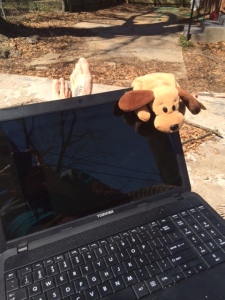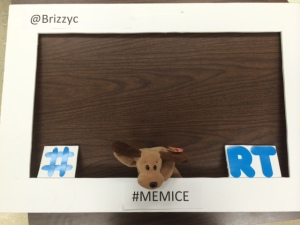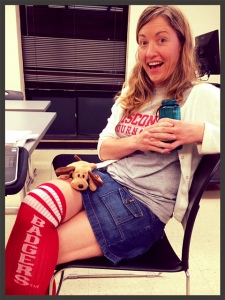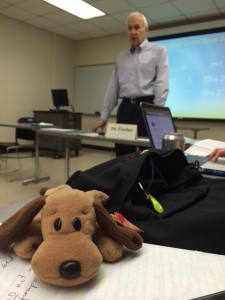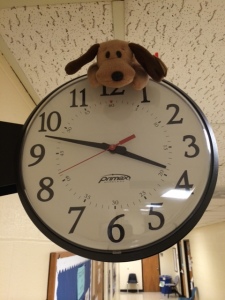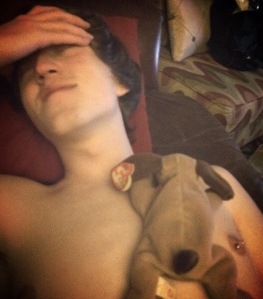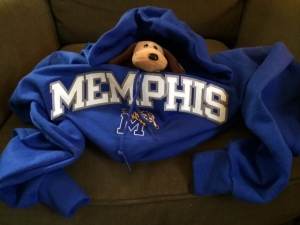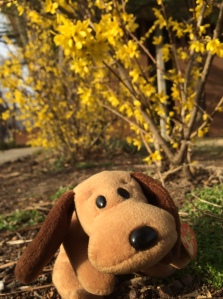Because my struggle with both the photo and video projects was directly related, as are the perceived benefits of utilizing both media in a social-media-driven world, I decided to sum up my reflections about both projects together.
First of all, my challenge for these challenges was rooted in my equipment. I had an old phone. It worked, but not like I wanted it to. My increasing awareness of how much less quality was demonstrated in my photoaday shots of Bones submitted to the class photo blog as compared to some of my classmates’ was already indication enough that I needed an upgrade. Then the added responsibility of trying to shoot even decent video footage with that old phone made a phone upgrade a requirement. But allow me to now say that this phone upgrade was long overdue for more reasons than these assignments. (I feel like a new man armed with this new device. It has already made my life easier in so many ways.!)
PHOTO:
As I previously discussed in the Photoaday Challenge blog and pertaining to the photo assignment, the mere shortcomings of my phone weren’t the only hangup. There is only so much one can do creatively with a phone camera. But in this aspect, I am pretty proud of myself. I feel like I overcame the limited functionality of this basic type of camera and produced some creatively composed shots.
But I must say that trying to come up with ideas for photos that were pertaining to a blog about gay male stereotypes on television was no small hurdle. I struggled with WHAT to even shoot for days. I could think of gay-related image ideas, but how to tie them to television was tough.
In an attempt to find people or objects that might even be affiliated with homosexuality in general, I spent some time at the Memphis Gay and Lesbian Community Center (MGLCC). I snagged a decent photo or two during the two days I spent there, but more than that and as a sidebar, I gained some new friends and new affiliations within the Memphis gay community that I think will help me feel more at home here. (I even joined a softball league. lol) But I still needed more photos for the assignment–and I was drawing blanks.
Because my photography attempt at the MGLCC didn’t really pan out where content for photos was concerned, I knew I needed to seek some further insight. Fortunately, I had made friends with University of Memphis staff photographer Rhonda Cosentino during my first visit to Memphis last summer. I turned to her for input, and her help was invaluable. She gets full credit for the concept of the two faceless men holding hands. (Thanks to Calvin Carter and Bret Weaver for posing for that shot!) She also had some other great ideas that I would’ve needed some models for, but I just didn’t have the resources or the opportunities (or the willing participants) to pull those off. But I can say that her insight inspired me to come up with some other ideas of my own–namely, the image of the television remote control swaddled in a rainbow flag. That concept and the resultant image make me proud of my work.
I’m also proud of the personal headshot of myself wearing earrings. This was gutsy move on my part, considering how I am perennially concerned about whom in the faceless internet audience might be seeing/reading imagery that I post. But I felt the image and the message were poignant enough with this particular shot to make the risk worth it. I composed a total of 16 photos and successfully posted them to my own new Flickr page, highlighting my three favorites on my blog.
All in all, I feel like I overcame both content and equipment challenges to pull off the Photo Assignment and depicted some creative imagery that reflects the topic of my blog, who I am as a gay man, and awareness of human equality in general.
VIDEO:
Composing a video relevant to my beat blog topic of gay male stereotypes on television was altogether a far more difficult endeavor.
My initial intent at how to compose this video was to draw on my professional experience as a television news reporter. It made sense to compose what would basically amount to a television news package, including interviews with members of the community including their opinions about the media’s treatment of gay men on television. With this in mind, I invested the two days at MGLCC, interviewing employees and volunteers for their opinions. I shot a good bit of B-roll footage at the center as well, trying to capture any images that may seem relevant to the topic.
That all might have been a good idea, except that literally almost none of the footage turned out at even decent quality on my old phone. Indeed, one of the most important segments of footage I shot turned out with NO audio AT ALL. (And I’m not altogether certain whether that was equipment or operator culpability.) Either way, when all was said and done after the two days’ excursion, I had no where near enough appropriate footage to compose a news package–and a volunteer who had grown weary of my presence and my needs. And it’s probably just as well that I had to scrap the tv news package idea anyways. I had no idea where or how I was going to edit the package using 3-audio tracks.
So after some more hours of stress, I devised a simpler plan that would involve less complicated editing but with which I could still fall back on my old television news skills. Armed with my new phone, I decided to create a faux newscast ‘breaking the news’ of non-traditional gay male types appearing on television.
That seemed like a tremendous idea that might seem creatively related to my beat blog–until I had to actually make myself do it. I can’t lie. I had as much fear about whether any of my old anchor skills were still intact as I did about what I would do with any decent footage I shot in the process. It’s been 15 years since I sat on an anchor desk, after all. I wasn’t sure I still had it in me.
As it turned out, I not only discovered I could still ‘anchor’ a ‘newscast,’ but that I am actually better at it than I used to be. Perhaps it was from many years of live emceeing a nightly music show at the Chattanooga Choo Choo Station House, or perhaps it was out of general sense of having matured. Whatever the reason, not only did I find it easy to create the faux newscast, I had a blast doing it. All by myself, in the privacy of my home, I let myself be free on the field and to just explore my own capabilities. I’m pretty impressed with what I produced. Never mind the two crazy characters I portrayed as a part of the newscast gave the actor inside a little opportunity to flourish as well. After a number of costume changes and a little bit of memorization to be prepared to recite the script, I was able to shoot footage I was happy with in the course of only a couple of hours.
Then came the next dreadful step–tackling iMovie software for the first time ever. But just as I fared with facing my fear of ‘anchoring’ again, I discovered that iMovie was far more user-friendly and easily navigable than I could’ve hoped. After a few Google tutorials and some pure determination, I managed to produce the 3-minute ‘newscast’ of Gay News Now in less than five hours. Wow. I couldn’t believe it. And in spite of my concerns about some of the content, I couldn’t have been more proud of what I created.
For the final stages of the assignment, including uploading the video to YouTube and posting the video to my blog, I found no difficulty. I had never really attempted to upload or embed videos this way, so naturally I was concerned. But the endeavor came off without a hitch. (And my apologies once again for needing the video to be posted to Facebook by someone other than myself. Understanding is much obliged.)
As to insight I gained about using photographic and video tools within the social media realm, I gained plenty. Clearly, to produce quality is paramount. And the attempt to do so can be laden with challenges. This felt not unlike my experience when I worked as a television news reporter, as equipment and operator malfunction was common. The incumbent responsibility, however, is to rise above any obstacles and strive to deliver quality product in a timely manner. I believe I managed to do just that and learned substantially about how to handle instances like the ones I dealt with in the future.
Further and more profoundly, it’s only the more obvious how utilizing photos and videos can amplify an online message and prompt further engagement in a noisy online world. Internet consumers have myriad options online. Content producers must be cognizant, and create as much specialized programming and content in as many media forms and channels as possible in any attempt to prompt engagement in the online community.

